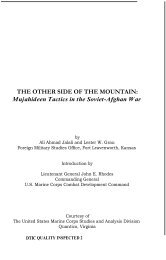hindustani fanatics, india's pashtuns, and deobandism â connections
hindustani fanatics, india's pashtuns, and deobandism â connections
hindustani fanatics, india's pashtuns, and deobandism â connections
- No tags were found...
You also want an ePaper? Increase the reach of your titles
YUMPU automatically turns print PDFs into web optimized ePapers that Google loves.
Hindustani Fanatics, India’s Pashtuns, <strong>and</strong> Deob<strong>and</strong>ism – ConnectionsDeob<strong>and</strong>i origins: A Highly Probable Connection to the Rohillas“It will be remembered that after the martyrdom of Syed Ahmad at Balakot divisions had opened up between the Wahhabi ‘Patna-ites’ led by WilayatAli <strong>and</strong> the Wahhabi ‘Delhi-ites’. For many years the latter were led by Shah Waliullah’s gr<strong>and</strong>son, Shah Muhammad Ishaq, whose cousin <strong>and</strong> brother-inlawwere Syed Ahmad’s first two disciples. Following the death of his cousin with Syed Ahmad in 1831, Shah Muhammad Ishaq <strong>and</strong> a group of his discipleshad migrated to Arabia. After an absence of many years he <strong>and</strong> his followers returned to Delhi, where Shah Muhammad Ishaq placed himself at the head ofa radical circle of scholars working within the traditions established by his gr<strong>and</strong>father. After Shah Muhammad Ishaq’s death in 1846 the Madrassah-i-Rahimiya broke up into a number of interlinked schools, of which the most obviously Wahhabi was that led by Maulana Sayyid Nazir Hussain of Delhi.“Born in 1805 Sayyid Nazir Hussain had begun his religious studies in Patna at the Sadiqpore house of one of the heads of the three Patnafamilies, Muhammad Hussain, <strong>and</strong> it was there that he first heard Syed Ahmed speak in the 1820s. He later moved up to Delhi to sit at the feet firstof Shah Abdul Aziz <strong>and</strong> then of his son <strong>and</strong> successor, Shah Muhammad Ishaq, becoming in time a highly respected teacher of Hadith. The degree towhich Sayyid Nazir Hussain participated in the 1857 Mutiny can only be guessed at.“The undisputed facts are that on 19 May 1857, eight days after the arrival of the mutineers from Meerut 91 , a group of mullahs erected agreen banner on the roof of the city’s greatest mosque, the Jama Masjid <strong>and</strong> published a fatwa proclaiming jihad. As soon as he heard of it, theEmperor ordered the banner to be removed <strong>and</strong> denounced the jihad fatwa as great folly because it would alienate his Hindu supporters. His actionswere supported by the Wahhabi ‘Delhi-ites’, but for very different reasons. Sayyid Nazir Hussain is said to have considered this declaration ofjihad to be ‘faithlessness, breach of convenant <strong>and</strong> mischief’, <strong>and</strong> to have pronounced that it was a sin to take part in it. But his reasons for doingso were essentially doctrinal: he <strong>and</strong> other Sunni fundamentalists viewed the emperor as ‘little better than a heretic’ on account of his insistenceon working with Shias <strong>and</strong> Hindus; <strong>and</strong> he did not consider Delhi to be a Dar-ul-Islam, making it unlawful to proclaim jihad from there. All theevidence suggests that the ‘Delhi-ites’ <strong>and</strong> other Sunni hard-liners in the city initially remained aloof from the mutineers <strong>and</strong> kept their own counsel.“However, everything changed with the arrival in Delhi on 2 July of a large contingent of sepoys accompanied by ‘three or four thous<strong>and</strong> ghazis[warriors of the faith but, in British eyes, <strong>fanatics</strong>]’. A significant number of these ghazis, led by one Maulvi Sarfaraz Alu, were Wahhabis. They hadcome from the town of Bareilly (not to be confused with Syed Ahmad’s birthplace in Oude, Rae Bareli), capital of Rohilk<strong>and</strong>, which in earlier dayshad been an Afghan-Pathan stronghold in the plains. Ever since Syed Ahmad’s day Bareilly had been an outpost of Wahhabism on a par with thatother Pathan bastion, Tonk.” 92As the Delhi mutineers began to split, there were some among them who decided to leave the city to create their own Dar-ul-Islam, an abodeof faith from which jihad could be proclaimed. Two of Nazir Hussain’s disciples leaving Delhi were Muhammad Qasim <strong>and</strong> Rashid Ahmad, keyleaders soon to become even more significant in the political-religious aspects of India.Charles Allen’s excellent work continued to explain this phase of the Mutiny:91. Meerut is located in Uttar Predesh, the region formerly controlled by Rohillas.92. Allen, pg. 137.Tribal Analysis Center, 6610-M Mooretown Road, Box 159. Williamsburg, VA, 23188
















